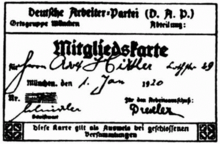- German Workers' Party
-
For the German Workers' Party in Austria-Hungary, see German Workers' Party (Austria-Hungary).
German Workers' Party
Deutsche ArbeiterparteiLeader Anton Drexler Founded January 5, 1919 Dissolved February 24, 1920 Preceded by None (de jure)
German Fatherland Party (de facto)Succeeded by National Socialist German Workers' Party Headquarters Munich, Germany Ideology Proto-Nazism Political position Far-right The German Workers' Party (German: Deutsche Arbeiterpartei, abbreviated DAP) was the short-lived predecessor of the Nazi Party (German: Nationalsozialistische Deutsche Arbeiterpartei, abbreviated NSDAP).
Contents
Origins
The DAP was founded in Munich in the hotel "Fürstenfelder Hof" on January 5, 1919 by Anton Drexler, a member of the occultist Thule Society. It developed out of the "Freien Arbeiterausschuss für einen guten Frieden" (Free Workers' Committee for a good Peace) which Drexler had also founded and led. Its first members were mostly colleagues of Drexler's from the Munich rail depot. Drexler was encouraged to found the DAP by his mentor, Dr. Paul Tafel, a leader of the Alldeutscher Verband (Pan-Germanist Union), a director of the Maschinenfabrik Augsburg-Nürnberg, also a member of the Thule Society, and his wish was for a party which was both in touch with the masses and nationalist, unlike the middle class parties. The initial membership was about forty people.[1]
On March 24, 1919, Karl Harrer (a sports journalist and member of the Thule Society) joined the DAP to increase the influence of the Thule Society over the DAP's activities, and the party name was changed to the "Political Workers' Circle". The membership was as scarce as the original DAP's and the meetings were reduced to the local beer houses.
Adolf Hitler's membership
Adolf Hitler, then a corporal in the German army, was ordered to spy on the DAP on September 12, 1919 during one of its meetings at the Sterneckerbräu, a beer hall in the center of the city.[2] While there, he got into a violent argument with one guest. Following this incident, Anton Drexler was impressed with Hitler's oratory skills and invited him to join the party. After some thinking, Hitler left the army and accepted the invitation, joining in late September. At the time when Hitler joined the party there were no membership numbers or cards. It was on January 1920 when a numeration was issued for the first time: listed in alphabetical order, Hitler received the number 555. In reality he had been the 55th member, but the counting started at the number 501 in order to make the party appear larger. Also, his claim that he was party member number 7, which would make him one of the founding members, is refuted. However, in his work Mein Kampf, Hitler claims that he received a membership card with the number 7. After giving his first speech for the Party on October 16 in the Hofbräukeller, Hitler quickly rose up to become a leading figure in the DAP.[citation needed]
From DAP to NSDAP
The small number of party members were quickly won over to Hitler's political beliefs. In an attempt to make the party more broadly appealing to larger segments of the population, the DAP was renamed on February 24, 1920 to the National Socialist German Workers' Party. The name was borrowed from a different Austrian party active at the time (Deutsche Nationalsozialistische Arbeiterpartei, German National Socialist Workers' Party), although Hitler earlier suggested the party to be renamed the "Social Revolutionary Party"; it was Rudolf Jung who persuaded Hitler to follow the NSDAP naming.[3]
Membership
As stated above, Hitler was the 55th member of the party. The following are well-known earlier members:
References
- ^ Hitler: a study in Tyranny by Alan Bullock
- ^ http://www.historisches-lexikon-bayerns.de/artikel/artikel_44810
- ^ Konrad Heiden, "Les débuts du national-socialisme", Revue d'Allemagne, VII, No. 71 (Sept. 15, 1933), p. 821
Political parties in Germany in the Weimar Republic (1918–1933) Communist Catholic Agrarian - Bavarian Peasants' League (BB)
- Agricultural League
- Schleswig-Holsteinische Bauern- und Landarbeiterdemokratie (SHBLD)
- Christian National Peasants' and Farmers' Party (CNBL)
- German Farmers' Party (DBP)
Liberal Conservative - German National People's Party (DNVP)
- People's Right Party (VRP)
- Christian Social People's Service (CSVD)
- Conservative People's Party (KVP)
Fascist Miscellaneous Categories:- Far-right and fascist parties in Germany
- Political parties in Weimar Germany
- Political parties established in 1919
- 1919 establishments in Germany
- Adolf Hitler
Wikimedia Foundation. 2010.

